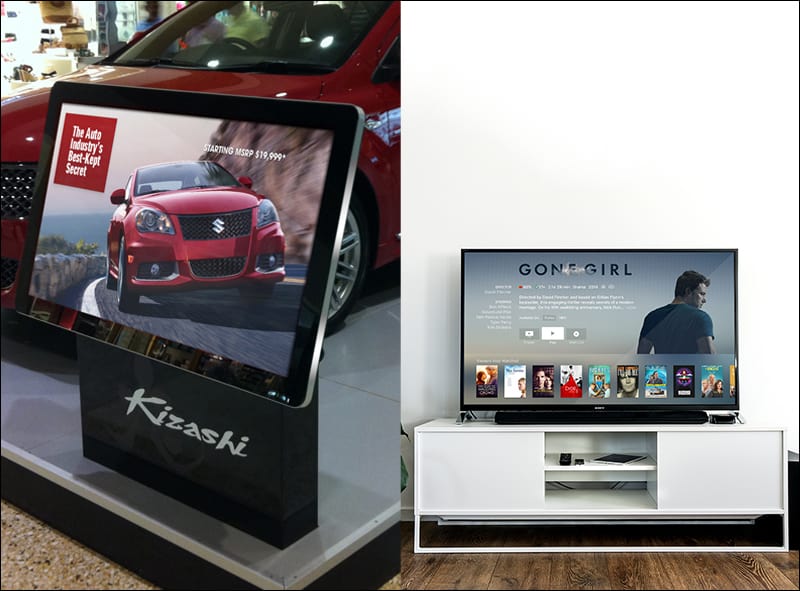
Digital Signage vs Televisions
At first glance some Digital Signage displays and domestic televisions may appear to be one and the same. They may look visually similar but their purposes are very different. A Digital Signage screen uses a commercial grade LCD panel and components and can be used for advertising purposes. A domestic television is a LCD screen for home entertainment. As a Digital Signage OEM we have seen customers come to us looking for commercial grade Digital Signage screens, only to end up buying a domestic television from a big brand electronics store because of a cheaper entry price. This is simple. A domestic television is NOT a viable Digital Signage solution but how exactly are they different?
To some people a screen is just a screen. For those who know, the difference in enclosures is immediately clear. Digital Signage displays are manufactured with commercial grade components that allow them to be in constant use 24/7 and you should expect to get at least 50,000 hours of use from Digital Signage displays. Domestic televisions however are not built to be in constant use. They are designed with shorter viewing periods in mind of more like 1-8 hours. If used for extended periods of time, televisions will suffer from image retention and color issues caused by the LCD panel becoming overheated. Digital Signage displays feature specialised cooling fans and ventilation systems to keep the panel at the optimum working temperature. A Digital Signage display will also have no external buttons or controls unlike a domestic television that normally have some form of exterior buttons that can control the display.
As such a bespoke piece of hardware Digital Signage displays normally come with extended warranty as manufacturers use more robust components in the manufacturing process and are built to last. That is why some Digital Signage manufacturers are able to replace individual parts when something goes awry. While domestic televisions do come with their own warranty, this would only cover for use within residential premises and not commercial applications. When something goes wrong with your television after the initial warranty is over, it’s your issue, end of story. It is also worth noting that if a domestic television used in a commercial environment were to cause a fire, this may invalidate your business insurance so it is always essential to see where you stand in regard to warranty.
The main crux of difference between Digital Signage displays and televisions are their functions and how the screen is able to achieve that. A Digital Signage screen uses an integrated Media Player that can run bespoke Digital Signage software that at its very basic function is capable of displaying images and videos in a constant loop and at its most advanced display multiple media zones such as locked down webpages , RSS feeds, images and videos all in one display. This allows the user to have complete control over the screen and the content on display. Older televisions used to only require a TV tuner to receive the signal or could be connected to external devices such as DVD players via HDMI or other ports. Newer ‘smart TVs’ now feature some kind of basic media player that allows for manually controlled slideshows of images and videos that are always in landscape orientation alongside unrestricted access to web browsers. The crucial difference though is that televisions are designed to be used by the broadest audience possible. With just a click of a button anybody can change the content on your television. There is no guarantee that you have ultimate control. In a commercial environment this is a major risk.
Domestic televisions are designed for use within the home. As standard they are optimized for their audience to be only mere feet away on a sofa, in standard lighting conditions and in landscape orientation. Digital Signage screens have a lot more to contend with. To get more eyes looking at their screen they have to have the largest viewing distances and angles available while still being fully versatile in terms of the orientation in which it is used. This is before having to content with more extreme lighting settings found in commercial environments so that is why Digital Signage displays often have brighter displays with a much better contrast ratio in comparison to televisions.
A screen is just a screen; unless it’s a Digital Signage screen. This kind of screen is an amazing piece of technology. Crafted for commercial environments this machine is purpose built for public information display purposes. No matter how much you spend on a television. However much you think you are saving when you don’t buy a commercial grade Digital Signage display, that money will all be wasted when in 6 months or a year you have to buy ANOTHER screen to replace the television when it breaks. Televisions are great in the home but that is where they should stay. With Digital Signage screens, the possibilities are endless.

Tom Rock is a Marketing Manager for Allsee Technologies. His background is in Digital Signage and Graphic Design.


